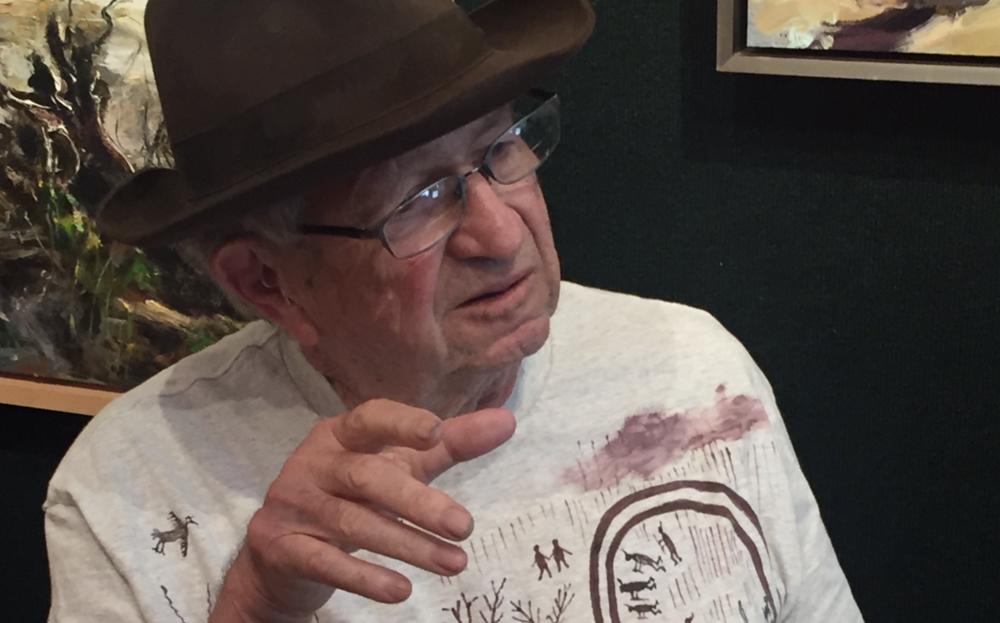Raoul Middleman’s personality is as colorful as his art.
That became vividly apparent in dual appearances at Plein Art Festival events Saturday evening: an interview and reception at the Troika Gallery, where 20 of his paintings are on display through Aug. 3, sandwiched around a film preview and question-and-answer adventure—you could call it performance-art storytelling—at the Avalon Theater.
Deservedly billed as “Legendary Artist” by the Troika Gallery, which sponsored the Avalon show and has represented him for 23 years, Middleman taught at Maryland Institute College of Art in Baltimore for 58 years until his retirement from teaching last month. His freewheeling, wide-ranging paintings are in the collection of, among others, the Baltimore Museum of Art, Corcoran Gallery/National Gallery of Art in Washington, along with the Metropolitan Museum of Art and National Academy of Design in New York.
Middleman, 84, describes his approach to painting as “a wrestling match. . . . I start out with a vague idea of what I’m going to paint and then the brush, the application, takes over. That’s an exquisite moment. What I come up with is a surprise, even to me.”
“His personality and storytelling are inseparable from his brushstrokes and narrative art,” says one of his thousands of former Maryland Institute students, Liz Parks. (Full disclosure: My wife participated in our interview with Middleman, reminding him when he recalled his youthful days in Montana as a ranch hand (of sorts) that his student, then known as Ms. Goodman, dubbed him “the Sam Shepard of art,” after the late playwright known for his American West vernacular.
In a scene from an in-progress documentary on his career, titled simply “Middleman,” screened at the Avalon, we see the artist shopping at Lexington Market. (He’s Baltimorean through and through.) In the market for scaly models, Middleman chooses four fish to take to his home/studio. Not to be fried, baked or broiled. But they are served up raw in a seafood still life, similar to one in the window of the Troika right now. He arranges them around a couple of lemons, also purchased at L exington Market, and slathers paint on the canvas as if filleting his catch. Then he changes his mind and reconfigures the scene.
exington Market, and slathers paint on the canvas as if filleting his catch. Then he changes his mind and reconfigures the scene.
His art has been described by critics as “messy and real,” reflecting the chaos of life and nature. If he has one particular muse, it’s “the super-funky Baltimore atmosphere,” citing filmmaker John Waters as a fellow-minded artist.
He majored in philosophy at Johns Hopkins University and hoped to become a writer until visiting a girlfriend in New Orleans who gently nudged him in the direction of art. Soon he was studying at Philadelphia’s Pennsylvania Academy of Art.
“I could always draw,” he said, adding, “If someone suggests you should do something different and that doesn’t work out, then you have two asses to kick.”
Like many artists in any field, Middleman declines to be confined to a single genre. Early on, he did Pop Art, which he gave up in pique over a dispute with a New York gallery owner. He turned to landscapes, about as far from Pop Art as you can get, and continued in landscape artistry periodically throughout his career. Several wreckage-of-nature paintings can be seen now at the Troika. For a time, at its height in the 1960s, he favored abstracts and later narrative paintings telling a story that could be re-interpreted by whomever beholds it.
He likens his progression to Renaissance painter Bellini, whose earlier paintings Middleman calls “linear” in style. Later, Bellini moved closer to the approach of many of his students, among them Titian—more painterly, more sensual. “To some, Bellini’s earlier work is his best,” Middleman says. But time bends fashion and taste. And what once was deemed hip is later dismissed as ho-hum. And vice-versa.
Middleman has ridden that wave throughout his career as a painter, even drawing inspiration from former students, trying new styles.
To his son’s question, Middleman recalled that at one point in his career he was an Abstract Expressionist.
“ ‘No you’re not, Dad,’ ” Middleman said. “You’re an Argumentative Expressionist.”
Apparently, the father agrees.
“Painting is an open question,” he says. “A good painting is kind of an argument. Whatever the artist may think it means, it may be something completely different to each viewer. So, there is no single right answer. Only questions.”
Steve Parks is a retired journalist, arts writer and editor now living in Easton.




Write a Letter to the Editor on this Article
We encourage readers to offer their point of view on this article by submitting the following form. Editing is sometimes necessary and is done at the discretion of the editorial staff.